Missing Number: Meaning, Reasoning Questions, Mock Test, Examples
Missing Number is a popular logical reasoning topic that challenges your ability to identify patterns, sequences, or relationships between numbers and then determine the value that fits logically in the missing place. In missing number reasoning questions, the numbers can be arranged in sequences, tables, or matrices, requiring keen observation and analytical skills. Whether it’s missing number matrix reasoning, find the missing number reasoning questions, or missing number MCQs from competitive exams like SSC CGL, mastering these patterns boosts both speed and accuracy. In this article, we will explore types, strategies, and examples of missing number reasoning to help you excel in exams. The missing number-based questions are asked in almost all entrance and government exams, such as CUET, MAH MBA CET, CLAT, JIPMAT, banking, SSC, and railways, among others.
This Story also Contains
- Types of Missing Number Reasoning Problems
- 1) Geometrical Shape-Based Missing Numbers
- 2) Matrix-Based Missing Numbers
- Solved examples of Find the Missing Number Reasoning Questions with Answers
- Verbal Reasoning Topics
- Missing Numbers Problems for SSC MTS/ SSC CHSL/ SSC Stenographer
- Missing Numbers Problems for SSC CPO/ SSC CGL
- Missing Numbers Problems for CUET/ Railway Recruitment Board exams
- Formulas and Tricks to Solve Missing Number Questions
- Non-Verbal Topics
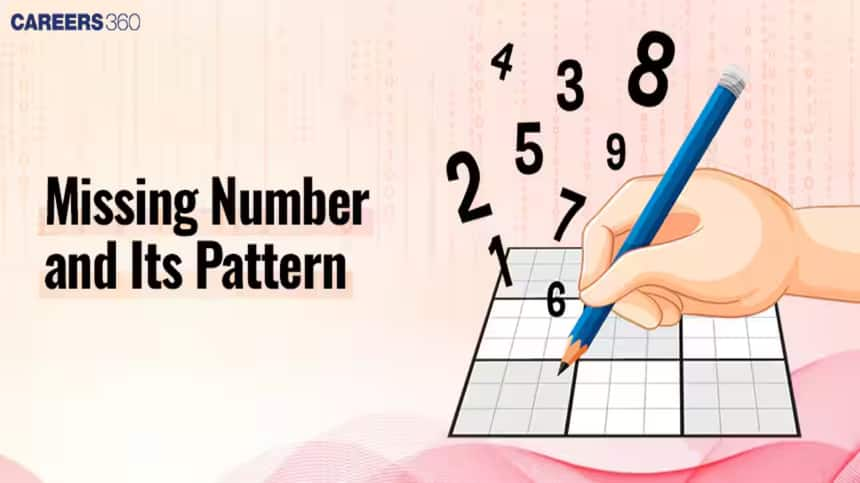
Types of Missing Number Reasoning Problems
Types of Missing Number Problems mainly include Geometrical shape-based missing numbers, where patterns are hidden in shapes, and Matrix-based missing numbers, where numbers follow specific rules in rows and columns. Practising both types enhances logical thinking and accuracy in competitive exams.
1) Geometrical shape-based missing numbers
2) Matrix-based missing numbers
Approach to Solve the Missing Number Reasoning Questions
First of all, check the order of the numbers. The order of the numbers is either in ascending order or in descending order, and then we determine the differences between the numbers that are next to each other to calculate the missing number, or we can find missing numbers by determining the pattern followed by the numbers/letters in the given series or figures. This pattern can be any of the mathematical operations, such as addition, subtraction, product or a combination of different operations. Now, let’s understand the types of missing number reasoning in detail:
1) Geometrical Shape-Based Missing Numbers
In such types of questions, different geometrical shapes will be given which consist of numbers/letters inside them following a certain rule/logic or sequence. The question may contain one figure or a combination of two or more figures. You have to find the logic among the given terms to find the missing term. Some of the figures with logic are explained below.
Example: Find the missing character from among the given alternatives.
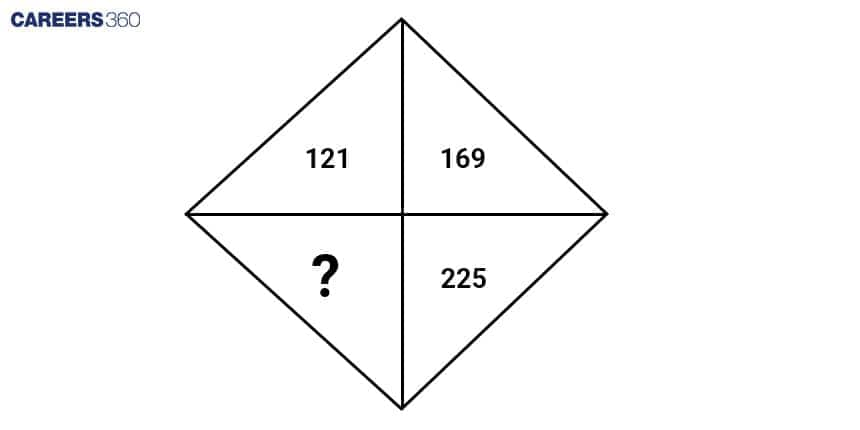
(a) 256
(b) 289
(c) 324
(d) 196
Solution: Here, the given numbers in the geometrical figure are the squares of consecutive odd numbers, such as $11^2 = 121$, $13^2 = 169$, $15^2 = 225$, $17^2 = 289$. Hence, the second option is correct.
Example: Find the missing character from among the given alternatives.
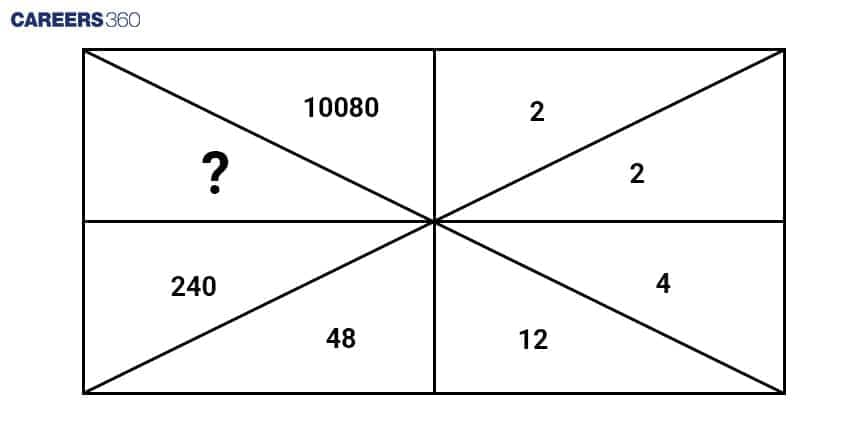
(a) 1540
(b) 1440
(c)1640
(d) 1720
Solution: Here, moving in the clockwise direction.
The pattern is as follows:
2 x 1 = 2;
2 x 2 = 4;
4 x 3 = 12;
12 x 4 = 48;
48 x 5 = 240;
240 x 6 = 1440;
1440 x 7 = 10080
Therefore, 1440 is the required answer. Hence, the second option is correct.
Example: Triangle missing number reasoning
Find the missing character from among the given alternatives.

(a) 5
(b) 6
(c)7
(d) 8
Solution: Here, the result of the multiplication of the outer numbers is divided by 10 to obtain the number inside the figure.
The pattern is as follows:
In the first figure: 5 x 4 x 2 = 40
40/10 = 4
In the second figure: 3 x 7 x 10 = 210
210/10 = 21
Similarly, in the third figure: 5 x 5 x 2 = 50
50/10 = 5
Therefore, the required number is 5. Hence, the first option is correct.
Example: Find the missing character from among the given alternatives.
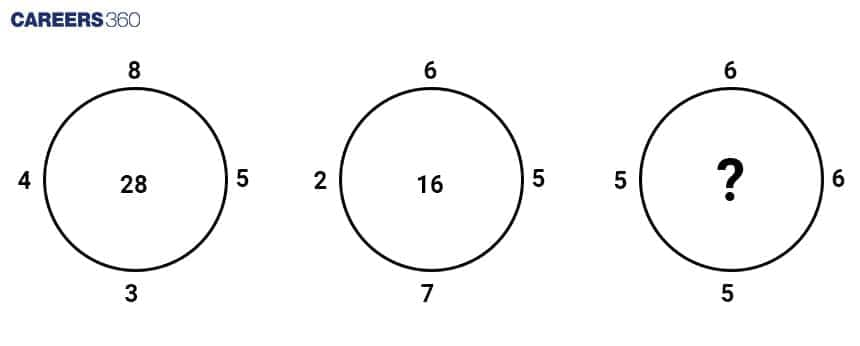
(a) 29
(b) 11
(c)28
(d) 13
Solution: The pattern is as follows:
In the first figure: (8 x 5) - (4 x 3) = 40 - 12 = 28
In the second figure: (6 x 5) - (2 x 7) = 30 - 14 = 16
Similarly, In the third figure: (6 x 6) - (5 x 5) = 36 - 25 = 11
Therefore, the required number is 11. Hence, the second option is correct.
Missing Number Reasoning Tricks to Solve Geometrical Shape-Based Problems
1) The first step is to identify the pattern used in the geometrical shape-based problems. There are some most common patterns, such as it could be the sum of two numbers divided by a constant, being an average of numbers or being in the form of letters, where the positional values of the letters are decreased or increased, etc.
2) You must know types of numbers, such as whole numbers, natural numbers, prime numbers, even numbers, odd numbers, etc.
3) Practice is key to success. Try to solve several missing number reasoning pdf questions by identifying the pattern, understanding the pattern behind it and continuing the practice.
2) Matrix-Based Missing Numbers
In such types of questions, a matrix having rows and columns will be given, which consists of numbers/letters inside it, following a certain rule/logic or sequence. You have to find the logic among the given terms to find the missing term. Some of the matrices with logic are explained below.
Example: Find the missing character from among the given alternatives.
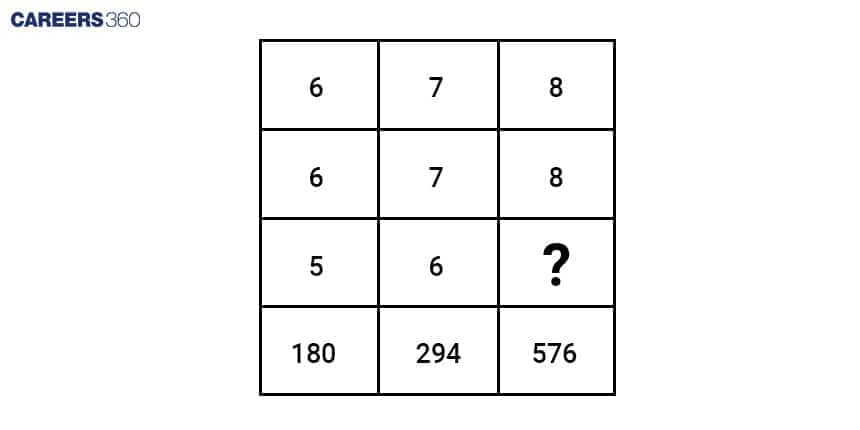
(a) 9
(b) 7
(c)5
(d) 12
Solution: The pattern is as follows:
In the first column: 6 x 6 x 5 = 180
In the second column: 7 x 7 x 6 = 294
Similarly, in the third column: 8 x 8 x ? = 576
? = 576/64 = 9
Therefore, the required number is 9. Hence, the first option is correct.
Example: Find the missing character from among the given alternatives.
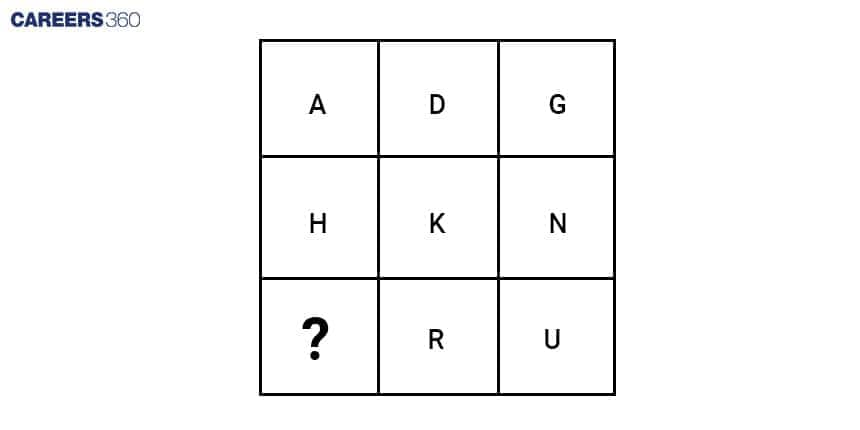
(a) P
(b) O
(c)Q
(d) R
Solution: The letters in the second and third rows are seven steps ahead of those in the first and second rows, respectively.
The pattern is as follows:
In the second column: D(4) + 7 = K(11); K(11) + 7 = R(18)
In the third column: G(7) + 7 = N(14); N(14) + 7 = U(21)
Similarly, In the first column: A(1) + 7 = H(8); H(8) + 7 = O(15)
Therefore, the required letter is O. Hence, the second option is correct.
Example: Find the missing character from among the given alternatives.
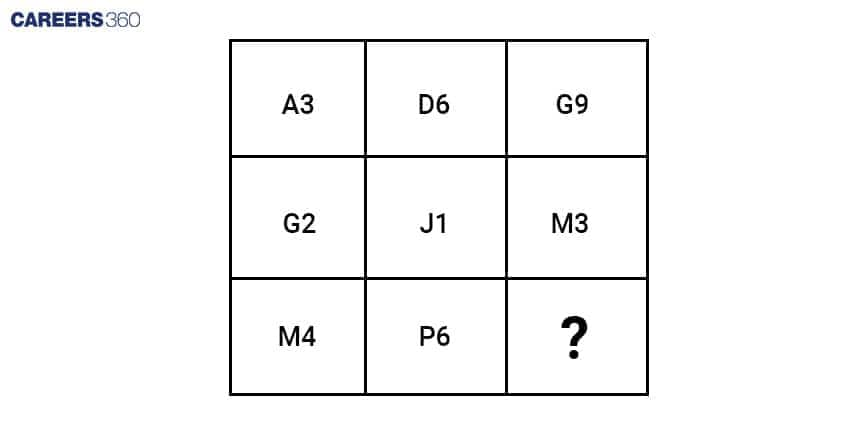
(a) S10
(b) U12
(c) V13
(d) R11
Solution: The letter in each row moves two steps forward and in each row, the sum of the first two numbers is equal to the third number.
In the first row: the letters - A(1) + 3 = D(4), D(4) + 3 = G(7); the number - 3 + 6 = 9
In the second row: the letters - G(7) + 3 = J(10), J(10) + 3 = M(!3); the number - 2 + 1 = 3
Similarly, in the third row: the letters - M(13) + 3 = P(16); P(16) + 3 = S(19); the number = 4 + 6 = 10
Therefore, the required term is S10. Hence, the first option is correct.
Missing Number Reasoning Tricks to Solve Matrix-Based Problems
First of all, determine the numbers/letters according to rows or columns to identify the pattern.
Once the pattern has been identified, then determine the rule that is applied to the numbers/letters it could be the BODMAS rule, squares, cubes, or it could be in the form of letters, where the positional values of the letters are decreased or increased, etc.
Practice is key to success. Try to solve several missing number reasoning practice sets or missing number reasoning MCQ by identifying the pattern, understanding the pattern behind it and continuing the practice.
After the solved examples, there is a number of reasoning questions with answers pdf available for your reference.
Solved examples of Find the Missing Number Reasoning Questions with Answers
1) Directions: In the following question, select the missing number from the given responses.
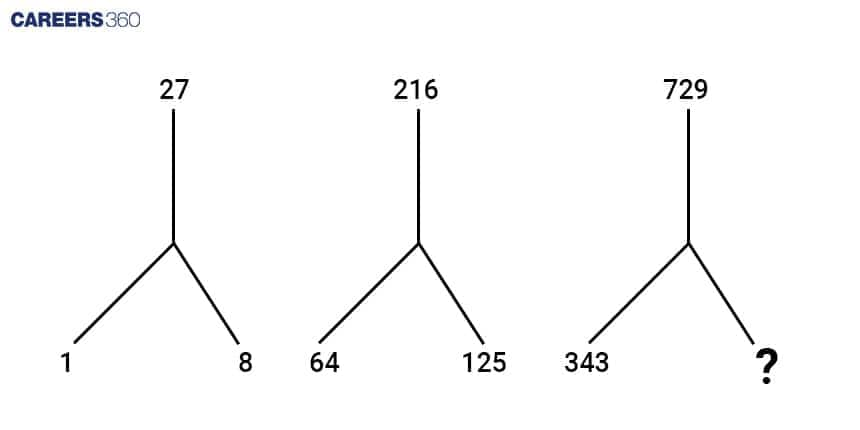
1) 432
2) 501
3) 512
4) 332
Solution:
The numbers given in each figure are the cubes of the consecutive natural numbers.
In the first figure: $(1)^3 = 1$, $(2)^3 = 8$, $(3)^3 = 27$
In the second figure: $(4)^3 = 64$, $(5)^3 = 125$, $(6)^3 = 216$
In the third figure: $(7)^3 = 343$, $(8)^3 = 512$, $(9)^3 = 729$
So, 512 is the missing number. Hence, the third option is correct.
2) Directions: In the following question, select the missing number from the given responses.

1) 1
2) 4
3) 9
4) 25
Solution:
The numbers given in each figure are the squares of the consecutive natural numbers.
In the first figure: $(2)^2 = 4$, $(3)^2 = 9$, $(4)^2 = 16$
In the second figure: $(1)^2 = 1$, $(2)^2 = 4$, $(3)^2 = 9$
In the third figure: $(3)^2 = 9$, $(4)^2 = 16$, $(5)^2 = 25$
So, 25 is the missing number. Hence, the fourth option is correct.
3. Directions: In the following question, find the missing number from the given alternatives.
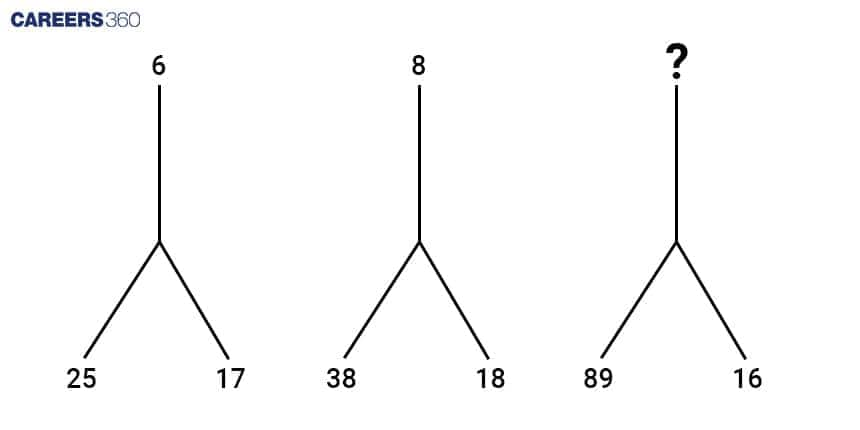
1) 13
2) 15
3) 17
4) 19
Solution:
Add two base numbers and divide the resultant number by 7.
In the first figure:25 + 17 = 42; 42 ÷ 7 = 6
In the second figure:38 + 18 = 56; 56 ÷ 7 = 8
In the third figure:89 + 16 = 105; 105 ÷ 7 = 15
So, 15 is the missing number. Hence, the second option is correct.
4. Directions: In the following question, find the missing number from the given alternatives.
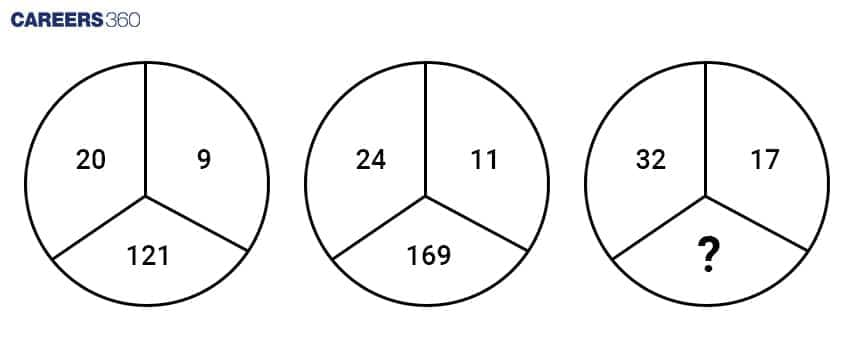
1) 125
2) 175
3) 225
4) 250
Solution:
The number at the bottom of the figure is the square of the difference between the other two numbers given in the figure.
In the first figure: $(20 - 9)^2 = (11)^2 = 121$
In the second figure: $(24 - 11)^2 = (13)^2 = 169$
In the third figure: $(32 - 17)^2 = (15)^2 = 225$
So, 225 is the missing term. Hence, the third option is correct.
5. Directions: In the following question, select the missing number from the given responses.
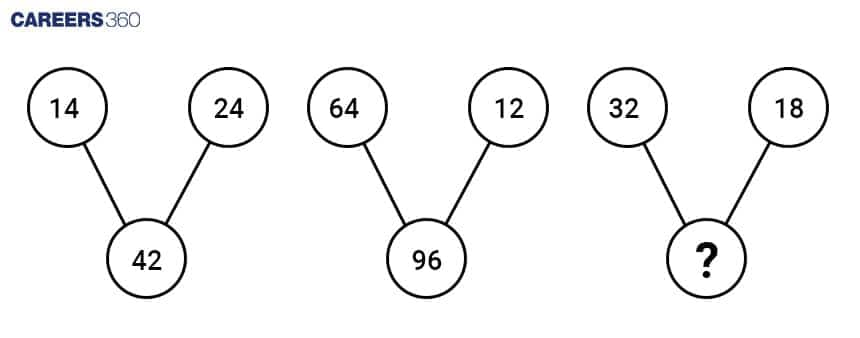
1) 60
2) 58
3) 65
4) 72
Solution:
To find the number at the bottom of the figure, divide the product of the other two numbers by 8.
In the first figure:(14 × 24) ÷ 8 = 336 ÷ 8 = 42
In the second figure:(64 × 12) ÷ 8 = 768 ÷ 8 = 96
In the third figure:(32 × 18) ÷ 8 = 576 ÷ 8 = 72
So, 72 is the missing term. Hence, the fourth option is correct.
6. Directions: Select the missing number from the given responses.
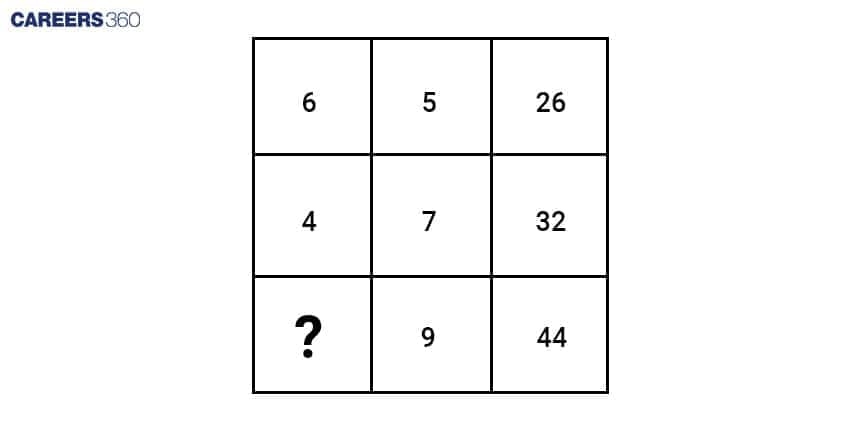
1) 8
2) 31
3) 32
4) 36
Solution:
The pattern can be observed running horizontally along the rows.
For each row, subtract the first number from the third number, then divide the resultant by 4 to get the second number.
First row: 26 – 6 = 20; 20 ÷ 4 = 5
Second row: 32 – 4 = 28; 28 ÷ 4 = 7
Third row: {44 – (?)} ÷ 4 = 9
⇒ 44 – (?) = 9 × 4
⇒ 44 – (?) = 36
⇒ (?) = 44 – 36
⇒ (?) = 8
So, the missing number is 8. Hence, the first option is correct.
7. Directions: In the following question, select the missing number from the given responses.

1) 6
2) 7
3) 10
4) 11
Solution:
Add the first two numbers given in the second row and divide by 2 to get the number between them in the first row.
The pattern followed is as follows –
In the first part; 16 + 20 = 36; 36 ÷ 2 = 18
In the second part; 18 + 22 = 40; 40 ÷ 2 = 20
In the third part; (9 + (?)) ÷ 2 = 8
⇒ 9 + (?) = 8 × 2
⇒ 9 + (?) = 16
⇒ (?) = 16 – 9 = 7
So, the missing number is 7. Hence, the second option is correct.
8. Directions: In the following question, select the missing number from the given responses.
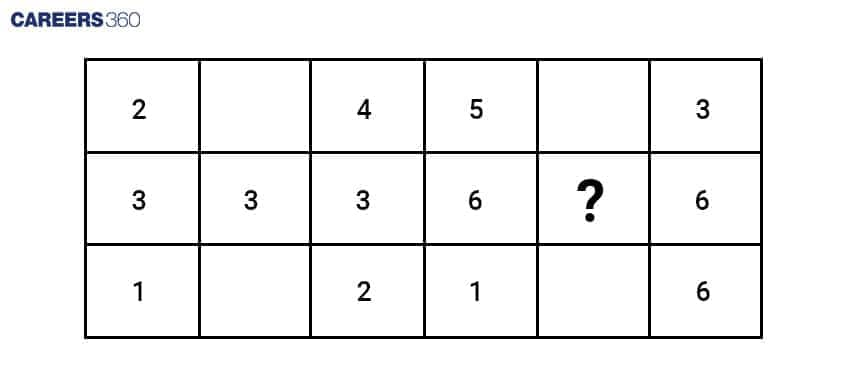
1) 5
2) 2
3) 3
4) 1
Solution:
The difference in the sum of the alternate column is equal to the number given between these columns.
The pattern followed is as follows –
In the first part; 2 + 3 + 1 = 6; 4 + 3 + 2 = 9:9 – 6 = 3
In the second part; 5 + 6 + 1 = 12; 3 + 6 + 6 = 15:15 – 12 = 3
So, the missing number is 3. Hence, the third option is correct.
9. Directions: In the following question, select the missing number from the given responses.
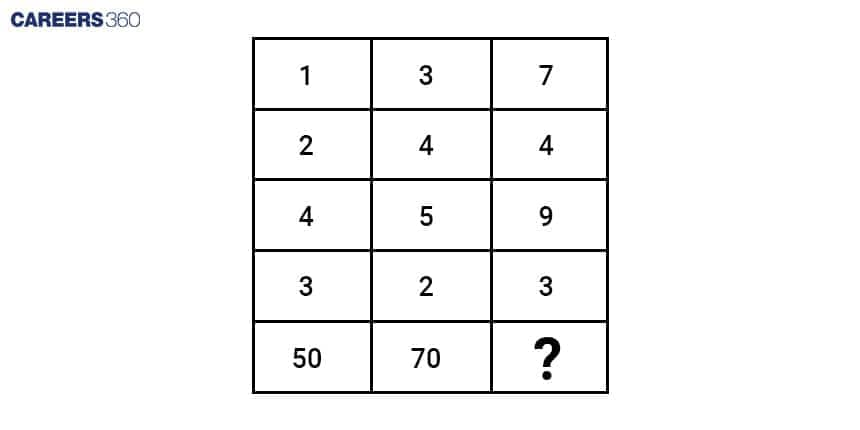
1) 23
2) 115
3) 118
4) 220
Solution:
Here, the sum of the first four rows is multiplied by 5 which is equal to the fifth row.
Like, in the first column; (1 + 2 + 4 + 3 ) × 5 = 50
And, in the second column; (3 + 4 + 5 + 2 ) × 5 = 70
Similarly, in the third column; (7 + 4 + 9 + 3 ) × 5 = 115
So, the missing number is 115. Hence, the second option is correct.
10. Directions: In the following question, select the missing number from the given responses.
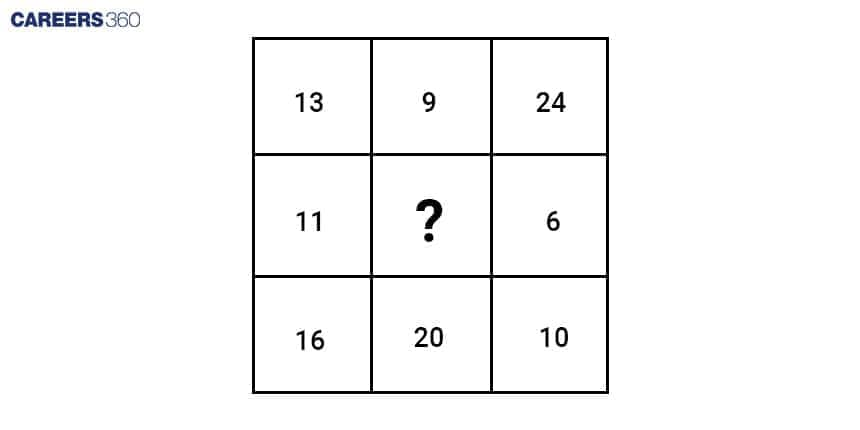
1) 11
2) 20
3) 19
4) 16
Solution:
Here, the sum of each column is equal to 40.
Like, in the first column; 13 + 11 + 16 =.40
And, in the third column; 24 + 6 + 10 = 40
Similarly, in the second column; 9 + ? + 20 = 40; ? = 11
So, the number that needs to be added is 11. Hence, the first option is correct.
For more questions, you should attempt the online missing number reasoning mock test and download the e-book of missing number reasoning questions pdf with the solution below:
Missing Number Questions with Solutions PDF
Verbal Reasoning Topics
Verbal Reasoning Topics include essential areas like Distance and Direction, Series, Seating Arrangement, Blood Relations, Calendar, Classification, Inequality, Order and Ranking, Puzzles, Coding-Decoding, Venn Diagrams, and Syllogism. Mastering these boosts logical thinking, speed, and accuracy in competitive exams. The most important verbal reasoning topics you must read:
Missing Numbers Problems for SSC MTS/ SSC CHSL/ SSC Stenographer
1) Directions: In the following question, select the missing number from the given responses.

1) 36
2) 117
3) 52
4) 26
Hint: Add and multiply the numbers on the top of the figure to get the numbers at the bottom of the figure.
Solution:
For each figure, multiply and add the numbers in the top left and top right corners to get the bottom left and bottom right numbers, respectively.
Figure one: 5 × 4 = 20; 5 + 4 = 9
Figure two: 3 × 8 = 24; 3 + 8 = 11
Figure three: 9 × 4 = 36; 9 + 4 = 13
Therefore, the missing number is 36. Hence, the first option is correct.
2) Directions: In the following question, select the missing number from the given responses.

1) 22
2) 24
3) 25
4) 28
Hint: Add and multiply the diagonally opposite numbers to get the other two numbers.
Solution:
For each figure, multiply and add the numbers in the top right and bottom left corners to get the top left and bottom right numbers respectively.
Figure one: 4 × 7 = 28; 4 + 7 = 11
Figure two: 5 × 5 = 25; 5 + 5 = 10
Figure three: 3 × 8 = 24; 3 + 8 = 11
Therefore, the missing number is 24. Hence, the second option is correct.
3) Directions: In the following question, select the missing number from the given responses.

1) 125
2) 25
3) 625
4) 1225
Hint: For each figure, determine the fourth power of the given numbers to get the missing number.
Solution:
For each figure, diagonally opposite numbers are equal to the fourth power of the number given in the top left and right corner of the square.
Like, in Figure 1: $(2)^4 = 16$, $(4)^4 = 256$
Figure 2: $(3)^4 = 81$, $(1)^4 = 1$
Similarly, in Figure 3: $(5)^4 = 625$, $(4)^4 = 256$
Therefore, the missing number is 625. Hence, the third option is correct.
Missing Numbers Problems for SSC CPO/ SSC CGL
1) Directions: In the following question, a series is given with one term missing. Choose the correct alternative from the given ones that will complete the series.
K | H | E |
B | Y | V |
S | ? | M |
1) R
2) P
3) O
4) L
Hint: Subtract 3 from the place value of the letters of each row to obtain the next letter.
Solution:
Subtract 3 from the place value of the letters of each row to obtain the next letter.
Row I: K – 3 = H; H – 3 = E
Row II: B – 3 = Y; Y – 3 = V
Row III: S – 3 = P; P – 3 = M
So, P is the missing term. Hence, the second option is correct.
2) Directions: In the following question, select the missing numbers from the given responses.
43 | 48 | 41 |
42 | 44 | ? |
47 | ? | ? |
1) 49, 45, 46
2) 45, 49, 46
3) 40, 48, 46
4) 46, 40, 45
Hint: Determine the missing numbers through the sum of all the numbers given in a row and a column.
Solution:
Let the missing numbers in a table be X, Y, Z.
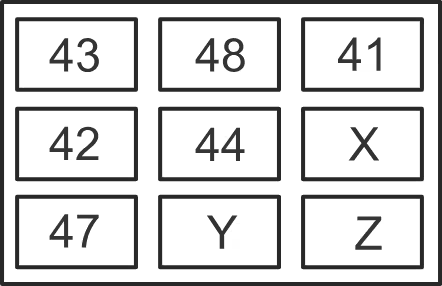
In the given table, the sum of all the numbers in a row and in a column is equal, i.e., 132.
Row 1: 43 + 48 + 41 = 132
Column 1:43 + 42 + 47 = 132
Row 2: 42 + 44 + X = 132
⇒ X = 132 – 44 – 42 = 46
⇒ X = 46
Column 2: 48 + 44 + Y = 132
⇒ Y = 132 – 48 – 44 = 40
⇒ Y = 40
Row 3: 41 + X + Z = 132
⇒ 41 + 46 + Z = 132
⇒ Z = 132 – 41 – 46 = 45
⇒ Y = 45
So, 46, 40, and 45 are the missing numbers in the given figure. Hence, the fourth option is correct.
Missing Numbers Problems for CUET/ Railway Recruitment Board exams
1) Directions: In the following question, select the missing number from the given responses.

1) 9
2) 40
3) 7
4) 36
Hint: Add the sum of the two numbers to the difference between the two numbers to get the missing number.
Solution:
Here, add the sum of top and bottom numbers with the difference of left and right numbers given in the box.
Figure one: (18 + 17) + (9 – 6) = 38
Figure two: (11 + 11) + (19 – 9) = 32
Figure three: (6 + 15) + (26 – 3) = 44
Figure four: (12 + 8) + (9 – 20) = 9
Therefore, the missing term is 9. Hence the first option is correct.
2) Directions: Find out the numbers that would fit in the second-row and third-row middle and last blank spaces (?) respectively.
18 | 23 | 16 |
17 | 19 | ? |
22 | ? | ? |
1) 26, 24, 25
2) 15, 21, 20
3) 21, 15, 20
4) 25, 24, 26
Hint: Check the sum of the numbers row-wise and column-wise.
Solution:
Here, the sum of the numbers in a row and the sum of the numbers in a column are equal to 57.
In the first row; 18 + 23 + 16 = 57
In the second row; 17 + 19 + (?) = 57 ⇒ (?) = 21
Now, in the first column; 18 + 17 + 22 = 57
In the second column; 23 + 19 + (?) = 57 ⇒ (?) = 15
Similarly, in the third column; 16 + 21 + (?) = 57 ⇒ (?) = 20
So, from the above 15, 21, and 20 are the required numbers of the given figure. Hence, the second option is correct.
Formulas and Tricks to Solve Missing Number Questions
Missing number reasoning problems become much easier to solve when you are familiar with the underlying mathematical patterns, quick tricks, and smart elimination strategies. Whether you are solving missing number reasoning SSC CGL all questions and answers or missing number MCQs for mock tests, knowing these methods will help you find answers faster and more accurately in the logical reasoning section.
Common Mathematical Patterns in Missing Number Reasoning
Many find the missing number reasoning questions follow standard numerical relationships. Identifying these quickly is key to solving them under exam pressure.
Pattern Type | Description | Example |
Numbers increase or decrease by a fixed value. | $3, 6, 9, _, 15\implies $ Missing Number = $12$ | |
Numbers are multiplied or divided by a fixed value. | $2, 4, 8, _, 32\implies $ Missing Number = $16$ | |
Square / Cube Patterns | Numbers are perfect squares or cubes. | $1, 4, 9, _, 25\implies $ Missing Number = $16$ |
Addition / Subtraction Across Rows | Used in the missing number matrix reasoning. The sum/difference of certain cells gives another cell. | Row sum rule: $A + B = C$ |
Multiplication / Division Rules | One number is obtained by multiplying/dividing other numbers in the sequence or grid. | $4, 8, _, 64\implies $ Missing Number = $16$ |
By practising different missing number reasoning questions, you’ll develop the skill to spot these patterns instantly.
Shortcut Methods
Competitive exams like SSC CGL, Banking, and Insurance Prelims demand speed. Here are some quick calculation tricks for find the missing number in reasoning problems:
Check differences first: If the numbers are close together, see if there’s an arithmetic difference.
Check ratios or multiplication: If the numbers vary widely, look for multiplication or division patterns.
Use reverse calculation: Start from the known last number and work backwards.
Look for alternate number patterns: Sometimes the sequence has two interwoven patterns (odd and even positions).
Example:
$5, 10, 8, 16, 14, _ $
Odd positions: $5, 8, 14\implies +3, +6\implies $ Next +9 $ \implies 23$
Even positions: $10, 16, _\implies +6, +6\implies 22$
Here, the missing number is 22.
Non-Verbal Topics
Non-Verbal Topics cover a wide range of reasoning skills that test your ability to understand patterns, shapes, and visual sequences without using words or numbers. Key areas of non-verbal topics that come under logical reasoning include Non-Verbal Analogy, Figure Series, Classification, Embedded Figures, Cube and Dice Reasoning, Figure Counting, Completion of Figures, Paper Cutting and Folding, and Mirror/Water Images. Mastering these topics helps boost problem-solving speed and accuracy in competitive exams. For non-verbal reasoning must read the following topics:
About the Faculty
Tanu Gupta, with over a decade of experience as a reasoning faculty, specializes in preparing students for various entrance examinations and career development. Her extensive work with multiple educational platforms and institutions has honed her expertise in logical and analytical thinking. Her dedication to innovative teaching methods ensures these articles provide practical insights and expert guidance.
Frequently Asked Questions (FAQs)
There are a total of two types of missing numbers in verbal reasoning i.e. geometrical-shaped missing numbers and matrix-based missing numbers. The number of questions of a particular type of missing number is not fixed for any exam. So, the examiner can ask any of these types of missing number questions in an exam.
The level of the questions of missing numbers has been seen as easy to moderate in the examinations.
In the SSC exams around 1-2 questions have been asked every year whereas in other exams like Railways, CUET or Defence mostly 2-3 questions have been asked.
Work on your Mathematics and basics to ace the missing number. Also, practice as many questions as possible because by practising you can identify the pattern in very less time.
No, there is no short trick to solve the questions based on missing numbers. The only method to solve the missing number is to identify the pattern. Aspirants just need to work on the basics of every subject asked in your exam and you are good to go.
To solve the missing number reasoning you have to follow or consider the pattern given in the figure. It can be addition, subtraction, multiplication, division, square or cube. You have to check according to the pattern of the figure.
First of all you have to rectify the pattern followed in the figure after that you should find similar differences between the missing number and given numbers to find missing number in reasoning.